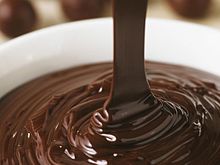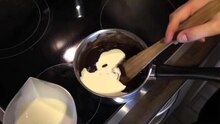Ganache
Ganache [ gaˈnaʃ ] (also Canache [ caˈnaʃ ]) is a cream made from couverture and cream that is used to fill and coat pastries and sweets . It can be made with both dark and milk chocolate and, for example , flavored with coffee , spirits , vanilla , nuts or almonds or refined with butter or egg yolk . Most variants of the ganache are to be counted among the creams because of their high cream content . It is often equated with Parisian cream , which has a different cream: chocolate ratio in Austria.
Manufacturing
The ratio of couverture to cream determines the consistency of the ganache: the higher the couverture content, the firmer the cream. Classic simple ganache contains cream and couverture in a ratio of 1: 2. This composition is also prescribed by the German Food Book for the claim of "Canache" as a filling for fine baked goods, but ganache creams with different compositions are also common for various purposes.
The couverture is chopped or grated, the cream is boiled and the couverture is dissolved in it. If necessary, you can homogenize the mixture with a stirring rod or vacuum mixer, then let it cool down. If butter is also incorporated, this happens when the mass has cooled to 30 ° C. After cooling, the cream is relatively firm, so you should stir it until foamy before processing.
Soluble coffee , mocha , rum , brandy , kirsch and vanilla can be used as flavoring ingredients . They can either be boiled with the cream or added together with the couverture, candied fruit , brittle or crushed nuts or almonds only after homogenization.
Use and variants
Ganache is suitable both as a filling and as a glaze for cakes and other pastries such as Carac (small, ganache-filled tartlets with fondant glaze). You can also inject or fondant dive or chocolate.
The term “Paris cream” is a softer variant with a cream-couverture ratio of 1: 1. Confectionery products made with it are designated with the attribute “Parisian…”, such as Parisian cakes , opera cakes , slices, etc. Also Ganache is used to fill truffle pralines or waffles. The “canache cream” (cream truffle mass) prepared for this also has a relatively high proportion of cream; butter is also added (hence “butter truffle”).
Invention and origin of name
Ganache was first made in the Parisian patisserie Siraudin around 1850 . The name of the cream is said to be due to a mistake made by an apprentice confectioner who mistakenly poured hot milk over chocolate. Thereupon he was insulted by the master as a ganache , which in French means, for example, fool or donkey. However, after the resulting product turned out to be quite edible, it got the name that was called when it was created.
Web links
- Ganache, Parisian creme, canache at "Lebensmittellexikon.de - Know what you are eating!"
Individual evidence
- ↑ a b c d René Kramer (Ed.): The great international confectionery book. Pastries, confectionery, desserts, ice cream, snacks, condiments . Pröpster, Kempten 1970, p. 196 .
- ↑ a b c d e Friedrich Holtz u. a .: Textbook of the pastry shop . 5th edition. Trauner, Linz 2009, ISBN 978-3-85499-367-4 , pp. 336 .
- ↑ German Food Book, Guidelines for Fine Baked Goods , Section I No. 7 (d)
- ^ Josef Loderbauer: The confectioner's book in learning fields . Verlag Handwerk und Technik, Hamburg 2009, ISBN 978-3-582-40203-5 .
- ↑ The history of patisserie ( Memento of September 3, 2011 in the Internet Archive ) (French)
- ↑ Article about the ganache ( Memento of the original from October 2, 2013 in the Internet Archive ) Info: The archive link was inserted automatically and has not yet been checked. Please check the original and archive link according to the instructions and then remove this notice. on the Internet portal of the Effilee magazine

